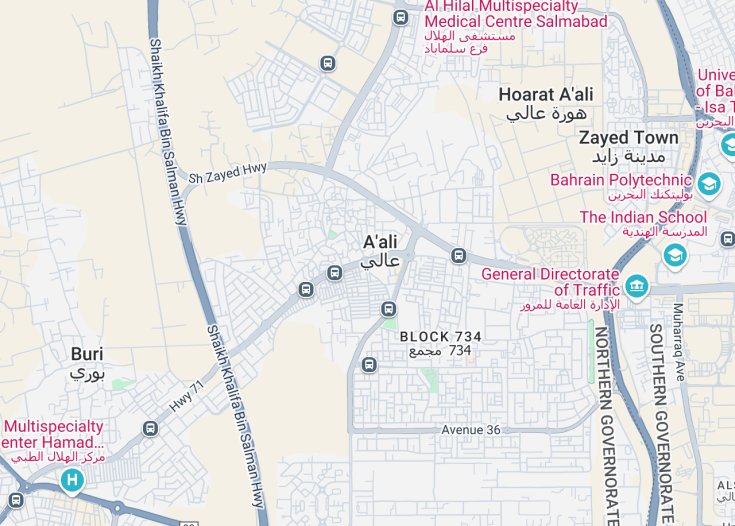Nestled in Bahrain’s central region, A’ali is renowned for its rich cultural tapestry and archaeological significance. Famous for its ancient burial mounds dating back to the Dilmun era, A’ali offers a unique glimpse into Bahrain’s prehistoric civilizations. Additionally, the town is famed for its traditional pottery, with skilled artisans preserving centuries-old techniques. Visitors can explore craft workshops, observe the intricate process and purchase unique earthenware. A’ali’s blend of historical depth and cultural vibrancy makes it a compelling destination for those eager to experience Bahrain’s heritage firsthand.
While visiting A’ali, make sure to spend time at the pottery workshops. Observing artisans at work offers an insightful peek into the traditional crafts of Bahrain.
Plan your visit to A’ali during cooler months to comfortably explore the outdoor archaeological sites and engage with the local artisans.
Top things to do & see in A’ali
Select the following sights and activities to discover best tickets and tours available in A’ali.
A’ali: A Historical Gem in Bahrain
| Country | Bahrain |
| Time in A’ali | GMT+3 |
| Language spoken | Arabic |
| Population | 49,330 (2020 Census) |
| Currency | Bahraini Dinar (BHD $) |
| Airports |
|
A’ali in Bahrain is a remarkable place, known for its rich history and cultural significance. Historically, A’ali is renowned for its burial mounds which are considered one of the largest prehistoric cemeteries in the world. The presence of these mounds indicates the area’s significance as a major hub of trade, religion, and culture from as early as 3000 B.C. More recently, A’ali has gained recognition for its pottery industry.
The traditional methods, passed down through generations, still survive today, providing a glimpse into Bahrain’s artisanal history and craftsmanship. Modern A’ali also plays a role in the local economy with its commercial and residential developments, making it a confluence of the past and the present. The town’s unique blend of ancient heritage and modern living attracts tourists and historians alike, making it an indispensable part of Bahrain’s cultural landscape.
Where is A’ali?
A’ali is situated in the heart of Bahrain, just 8 miles south of the capital, Manama.
Distances:
| Route | Distance by car | Time by car |
|---|---|---|
| Manama to A’ali | 8 mi / 13 km | 15 min |
| Riffa to A’ali | 5 mi / 8 km | 10 min |
| Muharraq to A’ali | 12 mi / 19 km | 20 min |
What is A’ali famous for?
A’ali is famous for its ancient burial mounds and vibrant pottery industry. These key features make it a significant archaeological and cultural site in Bahrain.
History
Prehistoric Period: Earliest Settlements
The area of A’ali in Bahrain has been of significant archaeological interest, primarily due to its rich history that dates back to the Dilmun civilization which is among the oldest in the region. Archaeological findings suggest that A’ali might have been settled as early as 5000 BCE. The area is renowned for its tumulus mounds, which are believed to be ancient burial sites.
3000 BCE – 600 CE: The Dilmun Era
During the height of the Dilmun civilization, A’ali became an important center, primarily because of its strategic location which facilitated trade across the Gulf region. It was during this period that A’ali began to flourish as an urban center, contributing significantly to the socio-economic and cultural development in Dilmun. Several burial mounds from this era have been excavated, revealing artifacts that help historians piece together the life and times of the Dilmun period.
600 – 1500 CE: Islamic Influence and Growth
With the spread of Islam across the Arabian Peninsula, A’ali witnessed significant changes. From around the 7th century onwards, A’ali saw the establishment of new administrative structures under Islamic governance. The Islamic period brought about advancements in agriculture, crafts like pottery, and the construction of mosques, which further stimulated A’ali’s growth into an important Islamic cultural center.
1500 – 1900 CE: Ottoman Rule
Under Ottoman rule, A’ali, along with the rest of Bahrain, was integrated into the broader imperial structure. The Ottoman influence is apparent in the architecture and urban planning of the village. This period also saw the continuation of traditional crafts such as pottery, which A’ali is renowned for even today.
1900s – Present: Modern Developments
In recent decades, A’ali has embraced modernization while maintaining its rich cultural heritage, particularly in pottery and traditional crafts. The village is now part of the suburban expansion of Manama but continues to be a significant site for both its historical importance and its cultural contributions to the Kingdom of Bahrain.
Visit A’ali
What to see and do in A’ali
Exploring A’ali offers a unique glimpse into Bahrain’s rich history and cultural heritage. Key attractions include:
- The Royal Tombs: Visit these ancient Dilmun burial mounds, which provide insights into early burial practices and beliefs.
- A’ali Pottery Workshops: Experience the traditional craft of pottery-making. Visitors can watch artisans at work and even try their hand at shaping their creations.
- Local Markets: Stroll through the local markets where you can purchase handmade pottery and other artisan crafts.
Guided tours through historical sites are available, offering in-depth history and stories behind these ancient landmarks.
Events in A’ali
The village hosts several cultural festivals and events throughout the year, celebrating its long-standing traditions in pottery and crafts. Notable events include the A’ali Pottery Festival held annually in spring, where artisans from across the region showcase their skills and sell their unique creations.
Best time to visit A’ali
The best time to visit A’ali is from November to March when the weather is cooler and more comfortable for exploring outdoors. This period also coincides with several local cultural events and festivals.
Is A’ali worth visiting?
A’ali is a captivating destination for those interested in history, culture, and traditional crafts. While the village offers a considerable appeal through its archaeological sites and artisan workshops, it might not cater as well to those seeking modern entertainment or nightlife. The village’s somewhat remote location may also pose accessibility issues for some travelers. However, for history enthusiasts and culture vultures, A’ali represents a poignant window into Bahrain’s ancient past and vibrant cultural scene, making it a worthy addition to a travel itinerary in Bahrain.









